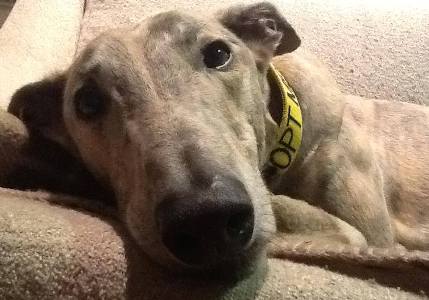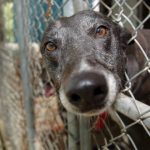Everyone knows the saying, “let sleeping dogs lie”. This is absolutely true – it’s generally best to leave sleeping dogs undisturbed wherever possible. Even the most docile, loving dogs can exhibit sleep aggression (growling or snapping when woken up from sleep). This is quite a common behaviour in all dog breeds, but especially in retired greyhounds.
For humans, being on the receiving end of sleep aggression from a greyhound can be frightening and may cause concerns about the dog having an aggressive or unfriendly nature. Nothing could be further from the truth. Many retired racing greyhounds exhibit sleep aggression for reasons related to their background, not their personalities. Understanding the reasons for sleep aggression can help new greyhound owners prevent it from occurring and maintain a loving, trusting relationship with their dog.
When they are racing, greyhounds are often kept in separate cages or kennels. Although there might be many other dogs nearby, they have their own little piece of independent space. Retired greyhounds must get used to sharing household space with other members of the family, including children and other pets, rather than having their own private ‘den’. They may feel that they need to be ‘on their guard’, even subconsciously, while they’re napping. If you remember their origins as wolves, keeping subconscious watch against predators in their den, you can see where this behaviour comes from.
A day in the life of a racing greyhound typically involves long periods of sleep between short bursts of activity (a pattern that they typically continue into their life as a pet!) This means greyhounds are used to long periods of uninterrupted rest. Having a human intrude on their sleep, even for something pleasant like a cuddle or a walk, is something that they have to get used to.
If your greyhound exhibits sleep aggression, providing them with a crate to sleep in might be a good solution. Your greyhound won’t see this as a cage but as a safe haven where they can feel secure. It’s also easier to prevent other dogs, cats or small children from entering the greyhound’s personal space. Having said this, the door should never be closed on a crate, whether the dog is in it or not, unless the dog is crate trained.
Another solution is to establish a house rule that the dog is not to be touched while on its bed, either asleep or not. Remember that some dogs sleep with their eyes open! If your greyhound sleeps in many different places, establish a rule that you will always call his/her name before you touch him/her and wait for a response before moving closer. Once you decide on the right rule for your dog, it will quickly become an easy habit, which makes life safer and more comfortable for your dog and your family.
Like all post-adoption adjustment issues, dealing with sleep aggression involves time, patience, awareness (of yourself and your dog) and common sense. Don’t put yourself or a family member in a situation that may be hazardous, and definitely do not let a sleep-aggressive greyhound share a bed with a sleeping human, especially a child. Ensure your greyhound has their own bed, and discourage them from sleeping in spaces used by humans to avoid territorial issues. Some greyhounds will overcome their sleep aggression as they gain confidence as a pet, but many will always require careful management.
Transitioning a greyhound from racing to pet life is always a learning experience for the dog and their humans. Coming to understand each other and how to live together happily and confidently is one of the great joys of getting to know one of these incredible dogs. Remember that your greyhound wants nothing more than to be a successful part of your family – but it can be hard for them to remember that they’re safe and loved when they’re fast asleep! Following these simple steps can help prevent sleep aggression from compromising your friendship with your beautiful, gentle dog.
Last modified: November 18, 2023




